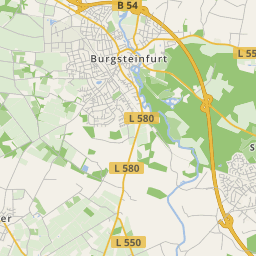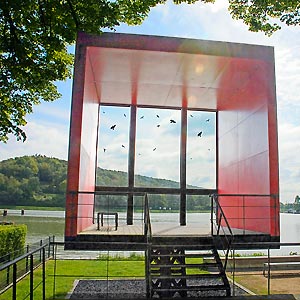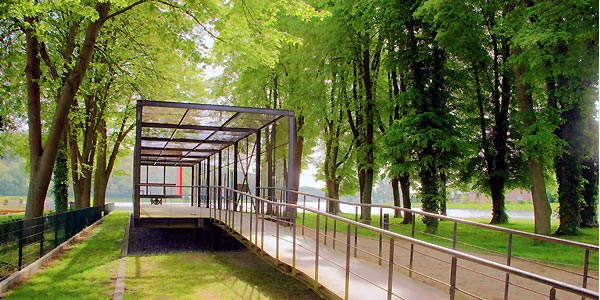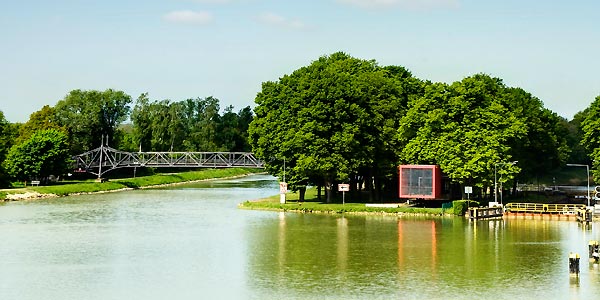












The 'Wet Triangle' between Bevergern and Riesenbeck represents the landscape diversity, also in reference to the canal history as a special place in the series of message gardens. Here in Bergeshövede, the Mittelland Canal branches off the Dortmund-Ems-Canal and ends after a length of around 320 km near bei Magdeburg into the river Elbe. For a long time, due to the setup of a towing business, the 'Wet Triangle' was the centre of inland waterway transport on the Dortmund-Ems-Canal and the Mittelland Canal. Gastronomical offers, the sluices and the landscape of the north-west foots of the Teutoburg Forest are popular with tourists still today. The 'Wet Triangel' adopts in the concept of the message gardens, respective of its outstanding importance a key role.

A special designed 'Exhibition Pavilion Canals' ('Red Box') documents the history and technique of waterways.
The eastern tip of the sluice island has been designed, beneath old lines of trees as viewing point. The hiking path along the canal guides visitors over a walkway to the long stretched 'Exhibition Pavilion Canals'. A body made of expanded metal transposes the motif of a sluice symbolically. In the new 'Exhibition-Sluice' picture and text signs explain the canals history and technique. There is also information about the town of Hörstel. A 'Red Box' at the tip of the sluice island, forms the scenic highlight of movement. It is viewing point as well as a visual reference point in the 'Wet Triangle'. The exhibition pavilion is the new landmark at the 'Wet Triangle' and stands symbolically for the message gardens.
The message garden 'Wet Triangle' was promoted in the course of project support Regionale 2004/ 'Kanalverband – Der arbeitende Flus' with contributions of the state North-Rhine Westphalia for town renewal.

The sluice Bergeshövede was built in the course of the Dortmund-Ems-Canal together with 15 further sluices in 1898. Already in 1950, some repairs and safety measurements were required. The existing operations building was built in 1953 and the control stand at the lower head in 1962 and in 1980 fully restructured. In 1958, the water level was raised by 0,50m and the thus the permitted ship sizes increased. The motors received electric Dremo-motors in 1962. The bridge was replaced in 1981/82. The needle throw was fundamentally reconstructed in 1986 and is right now damaged again. The sluice got new gates in 1989. In preparation for the needed construction examination in the year 2005, damage at the needle throw was detected yet again, which made draining impossible. Right now, further partial renovation at the sluice would be necessary. But as the sluice is not in use for shipping and is not needed for water level regulation, a partial demolition and backfill of the sluice Bergeshövede is seen as necessary.

The backfill could be stopped just in time by the town of Hörstel in collaboration with the Westphalian Office of Preservation of historical Monuments Münster. In autumn 2006, the sluice Bergeshövede was added preliminary to the monument list. With a lock chamber measurement of 67,00m /8,60m, the sluice Bergeshövede depicts a typical representative of the 1st sluice generation, designed for the normal ship type. It enqueues into the list of the few still preserved constructions of the first planning and operation period. The sluice Bergeshövede takes an outstanding role in the listing as one of the last originally preserved function units for the Westphalian area and is a document of technique and transport history. In addition, the functional interaction of water as transport mode and functional building, is self explanitory.